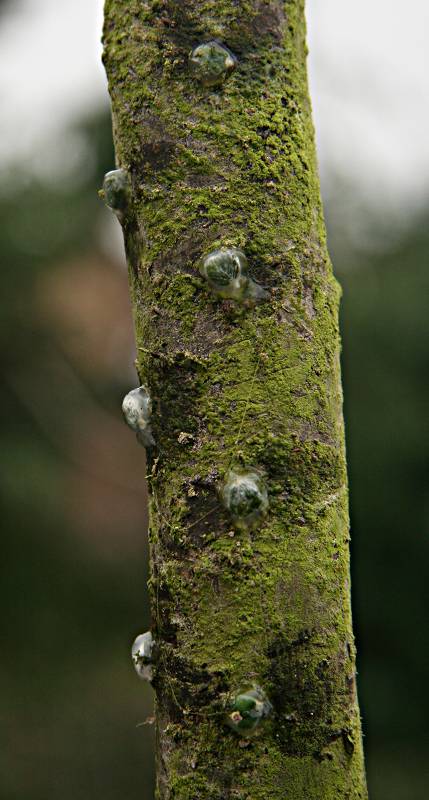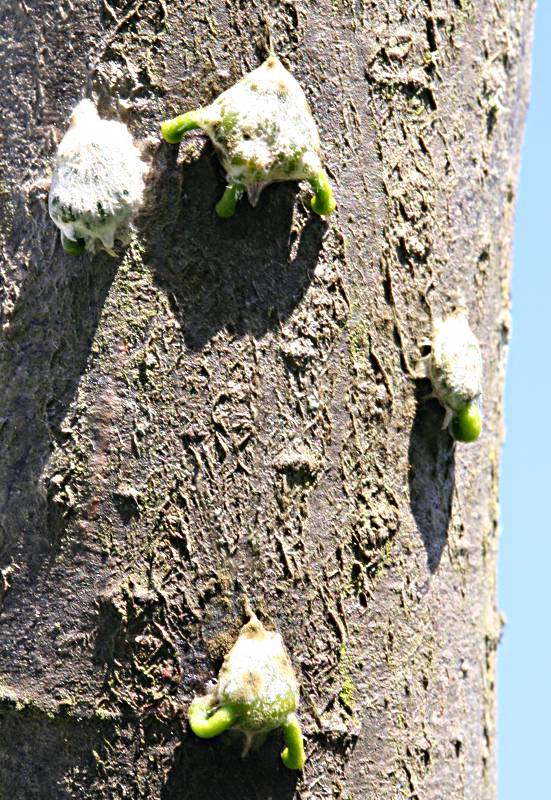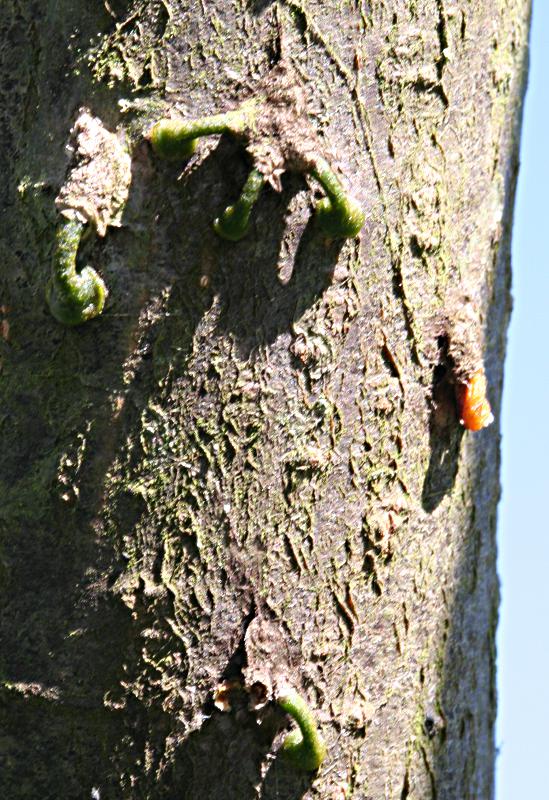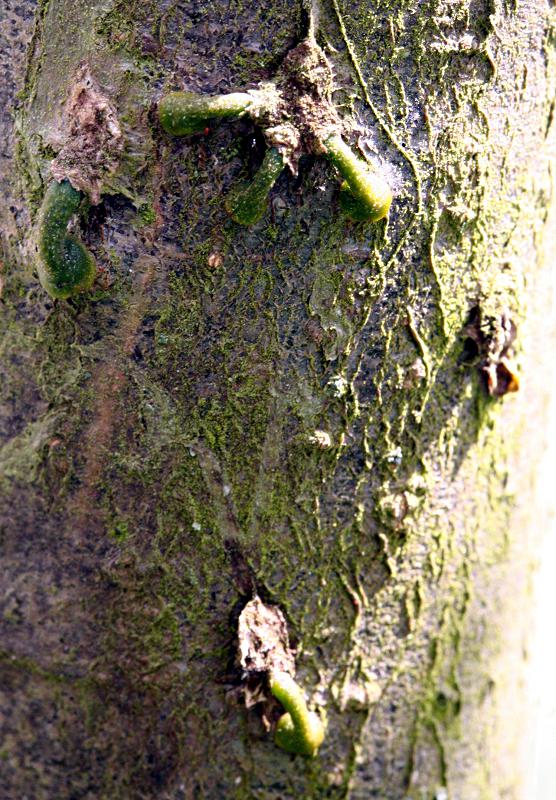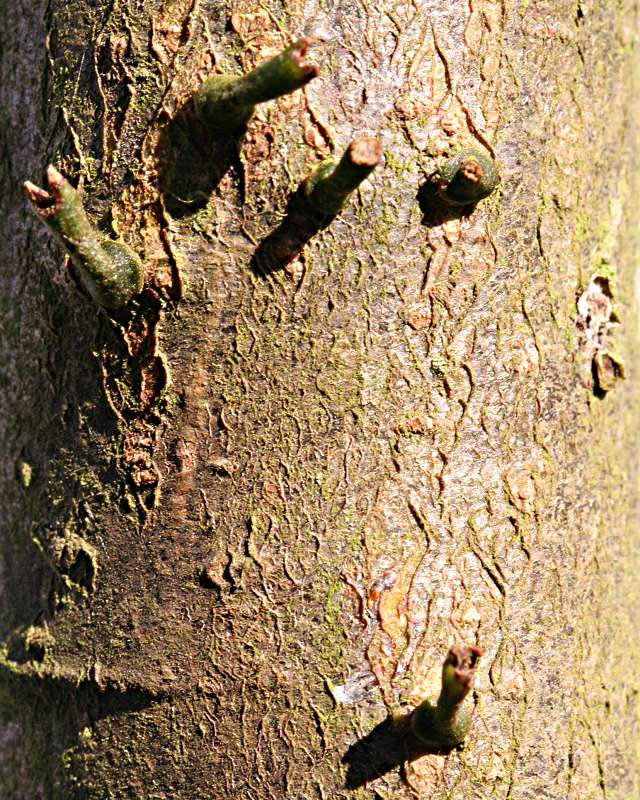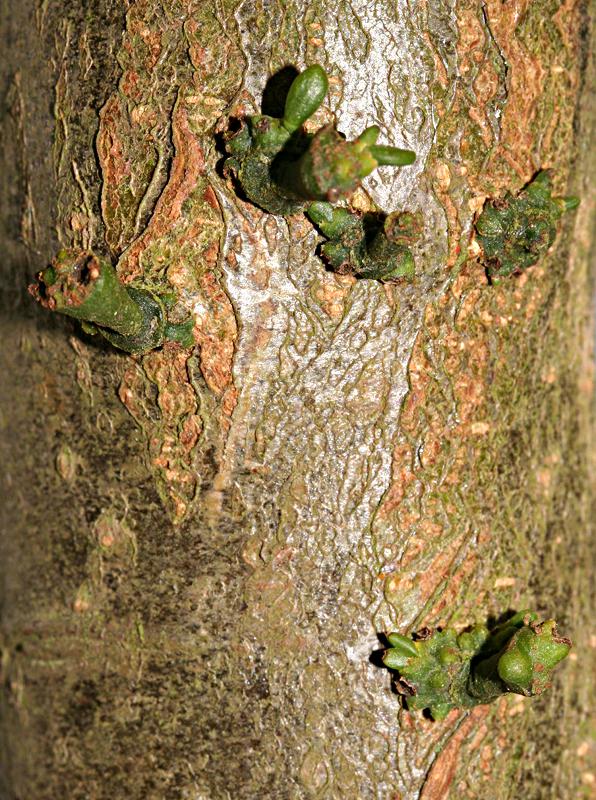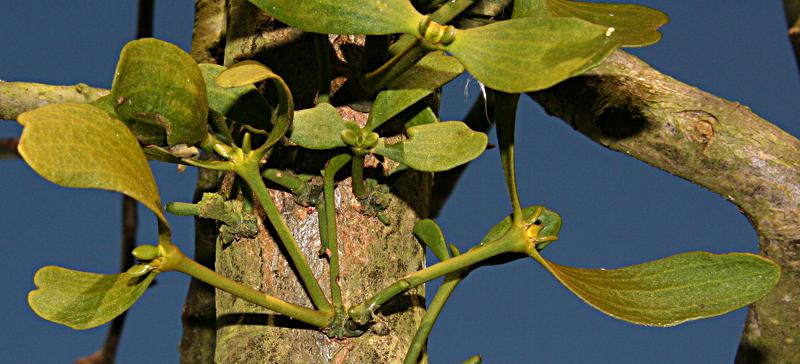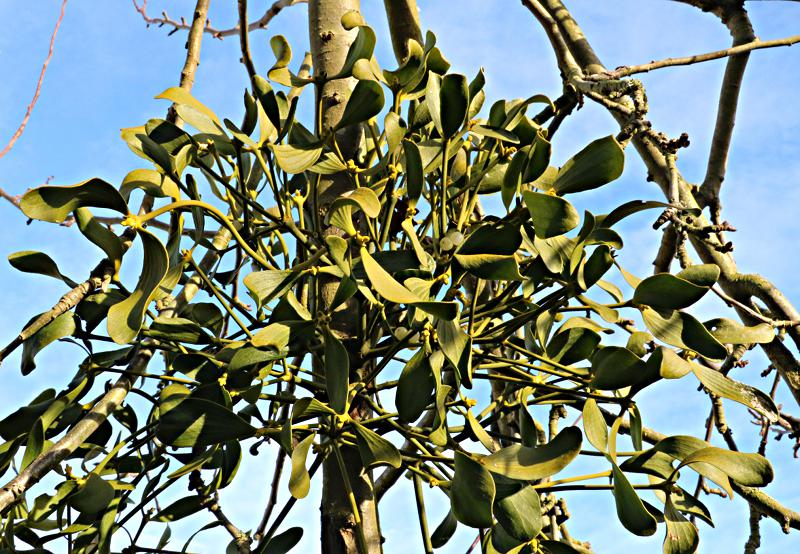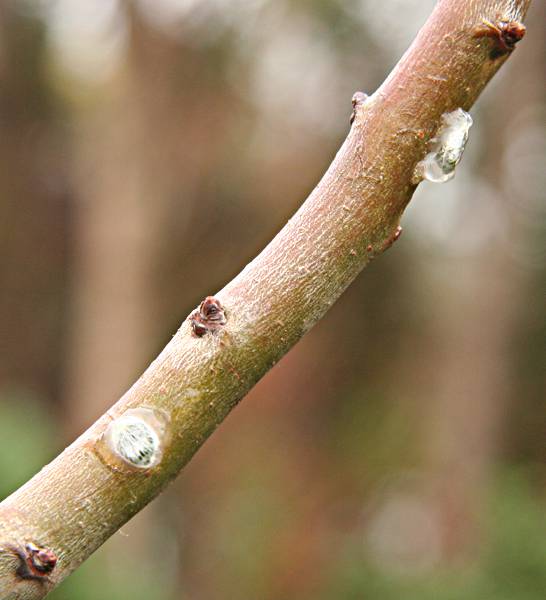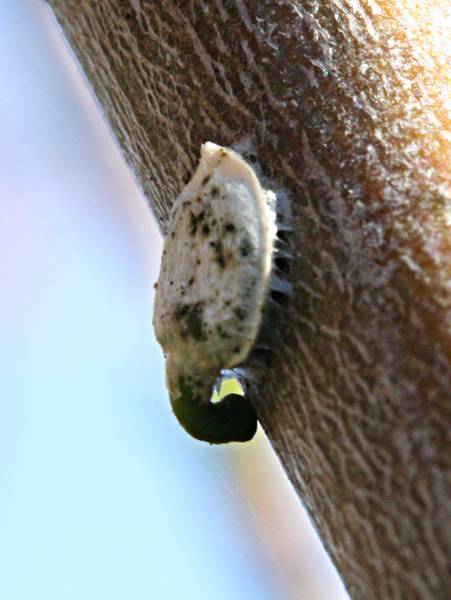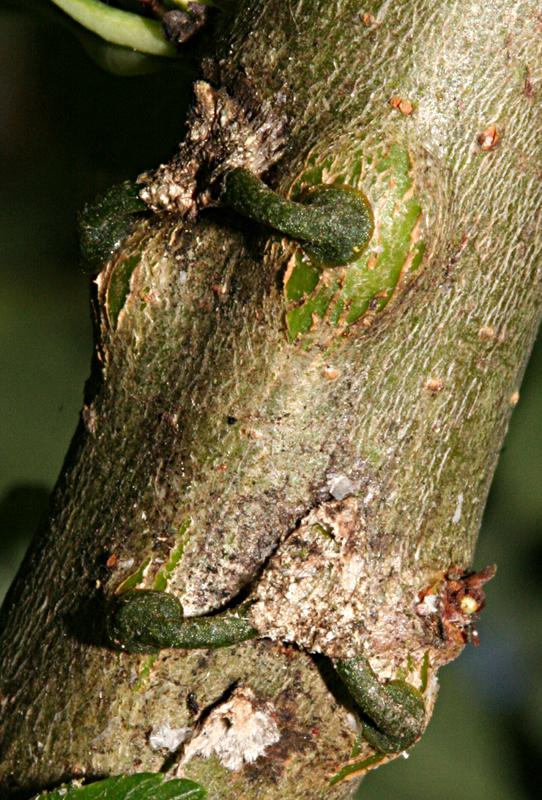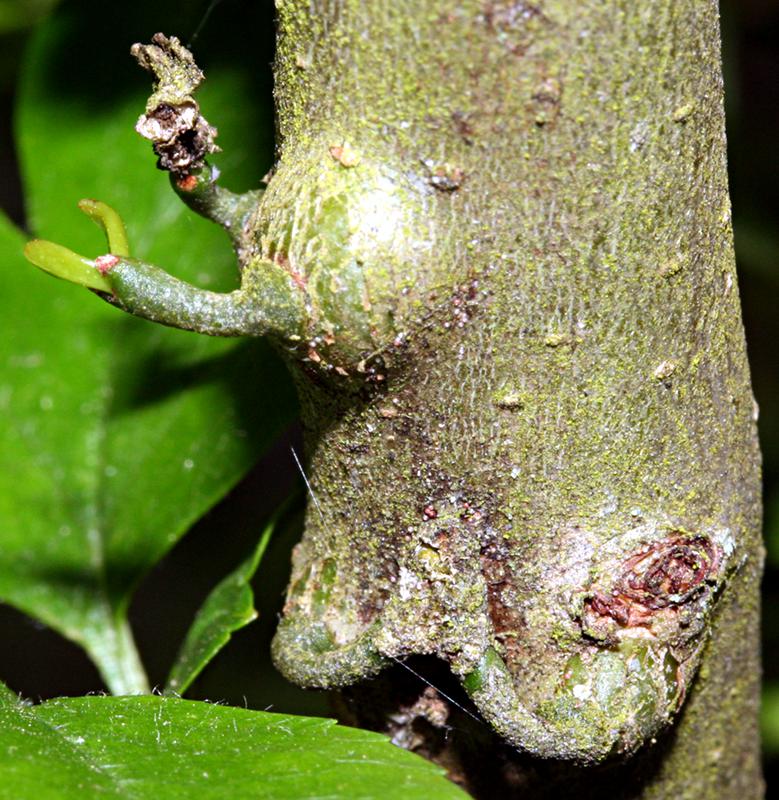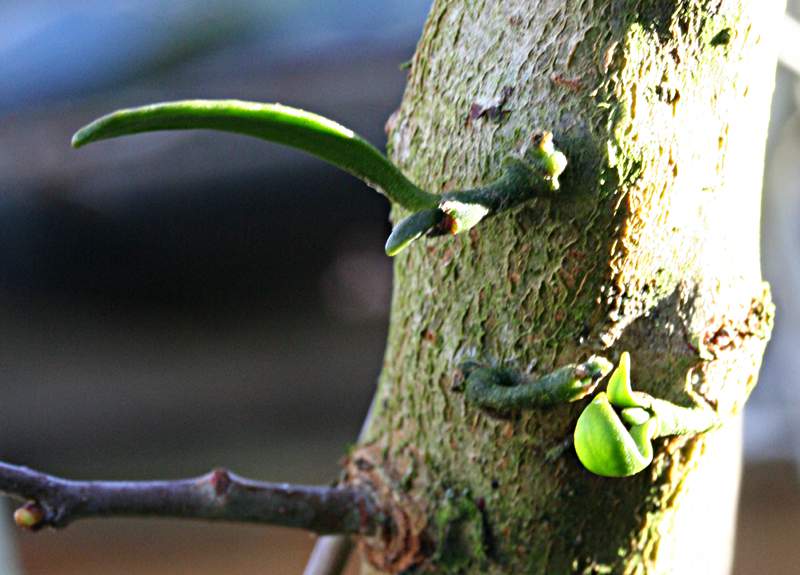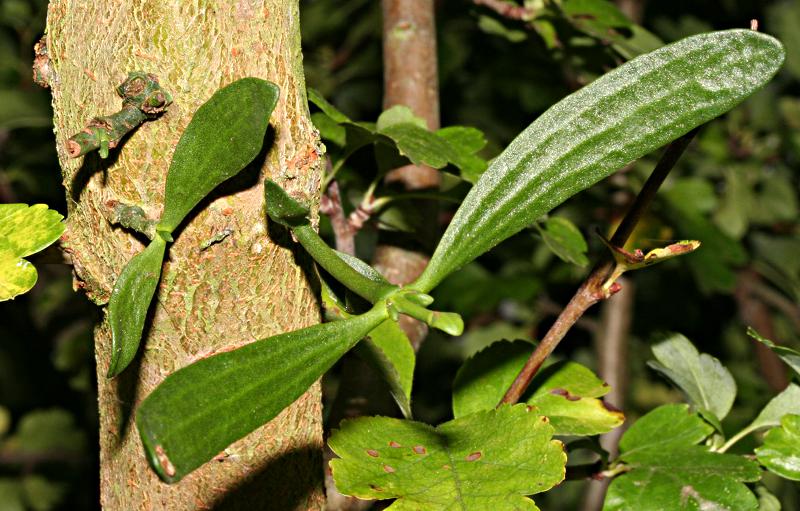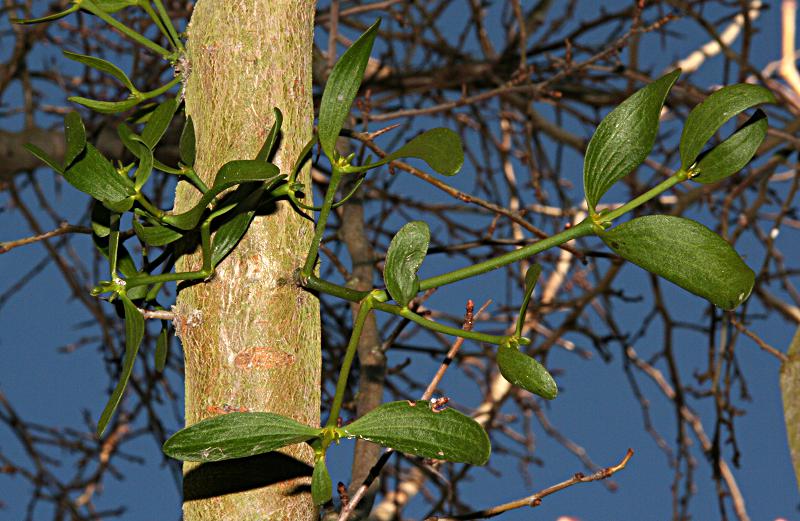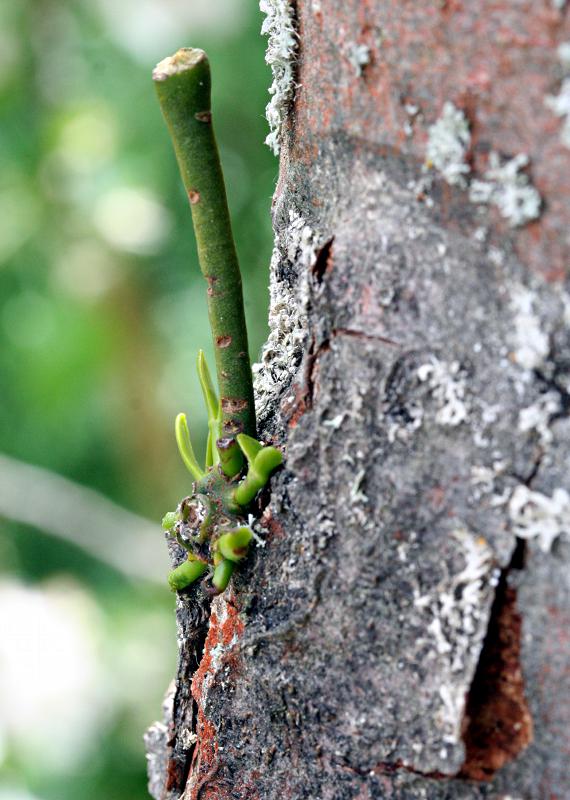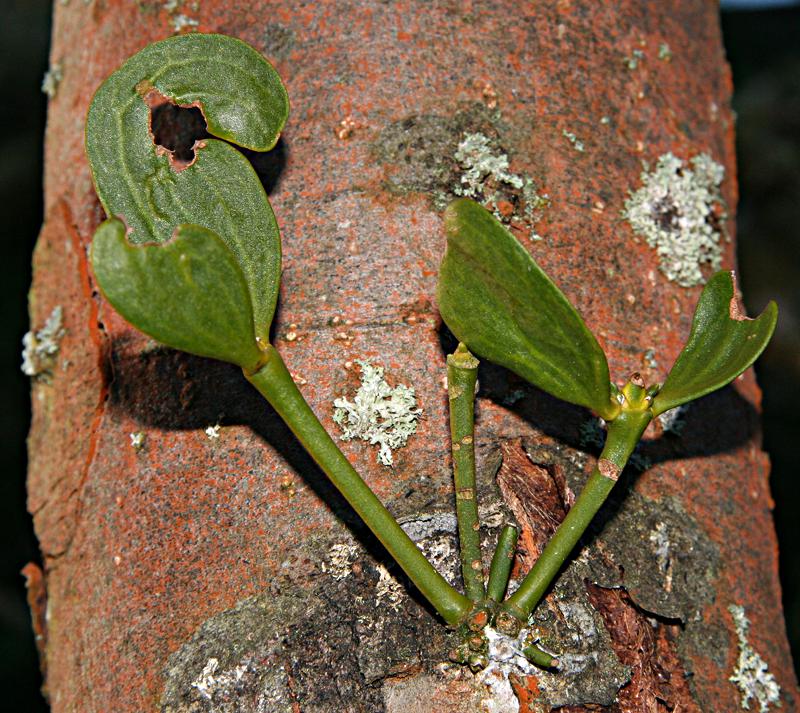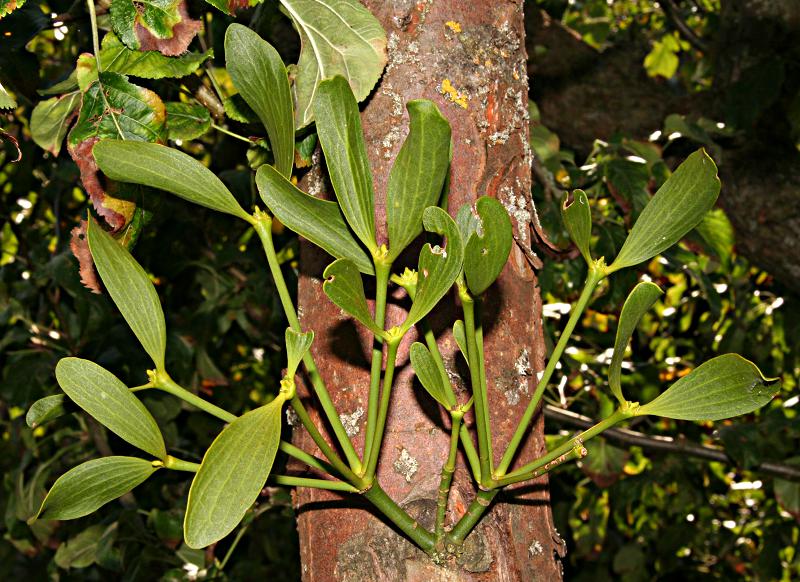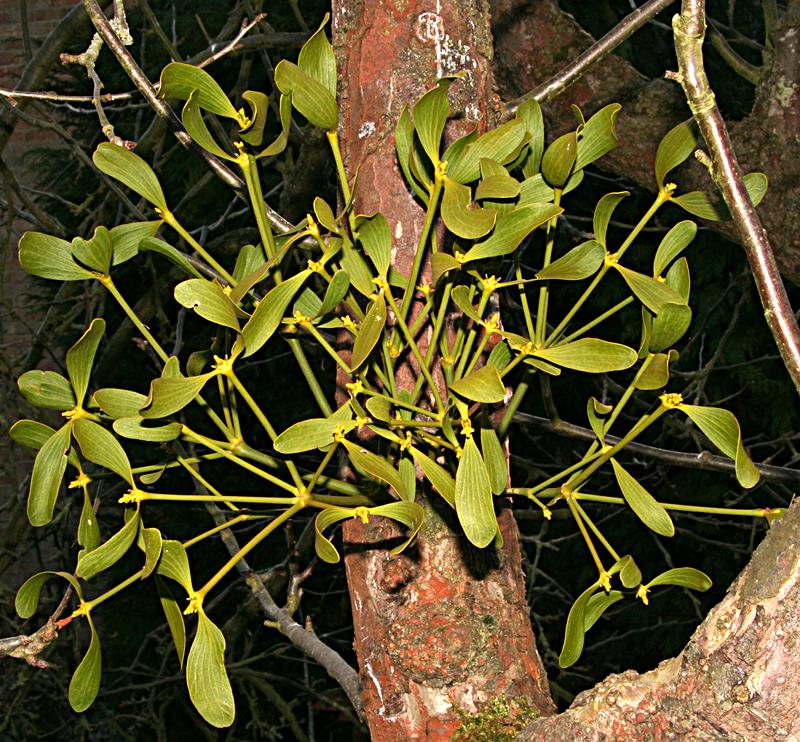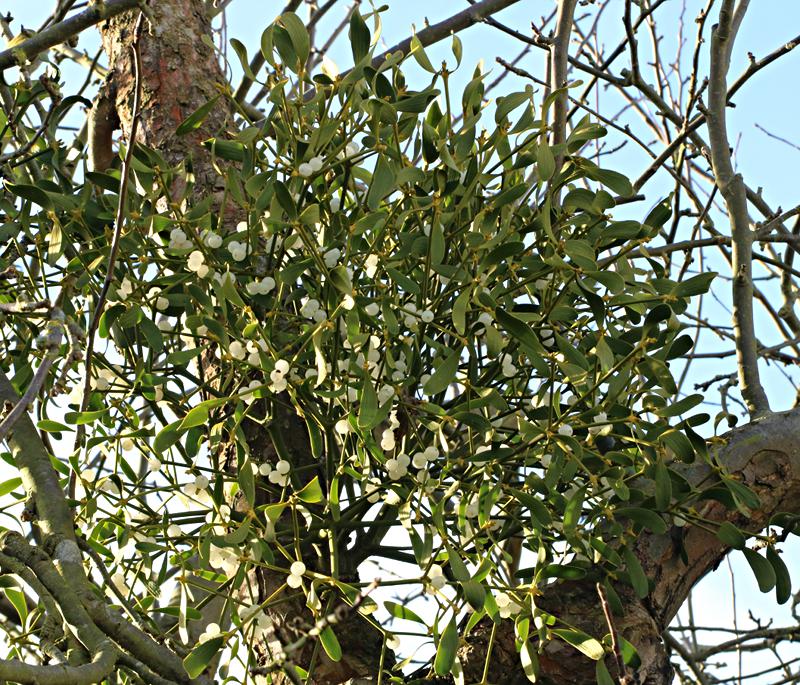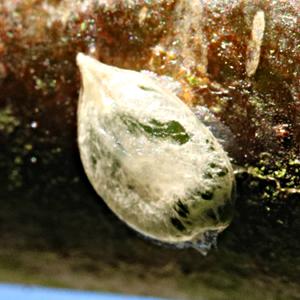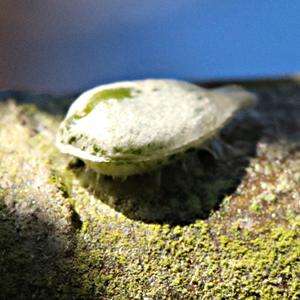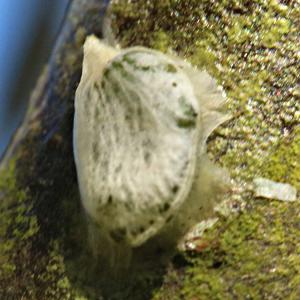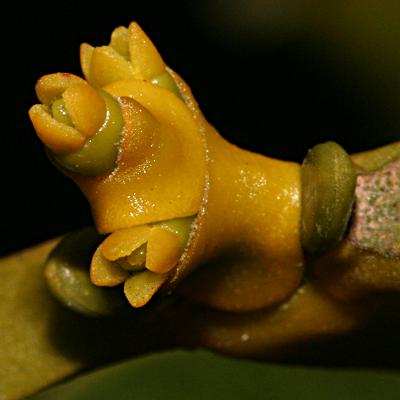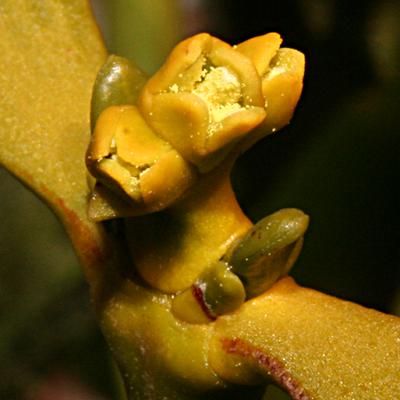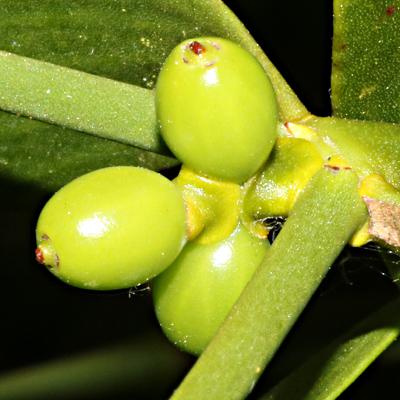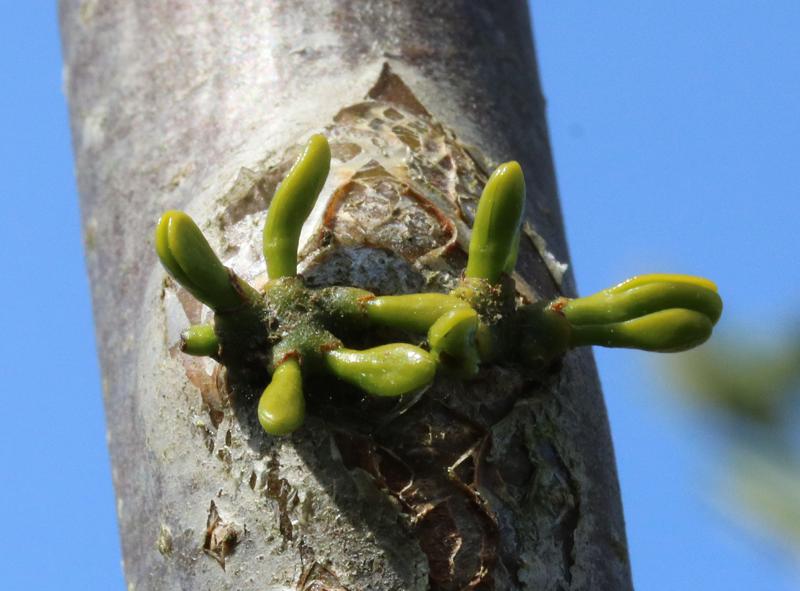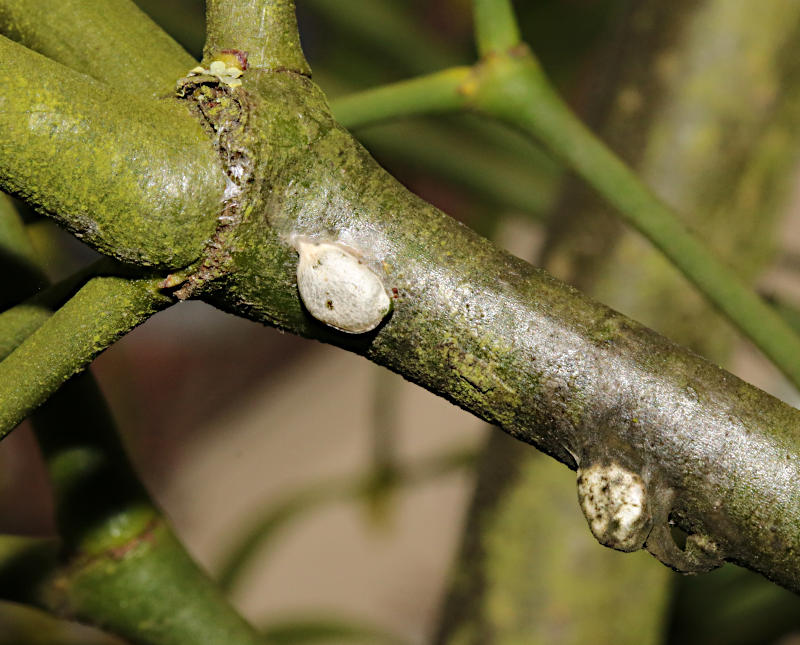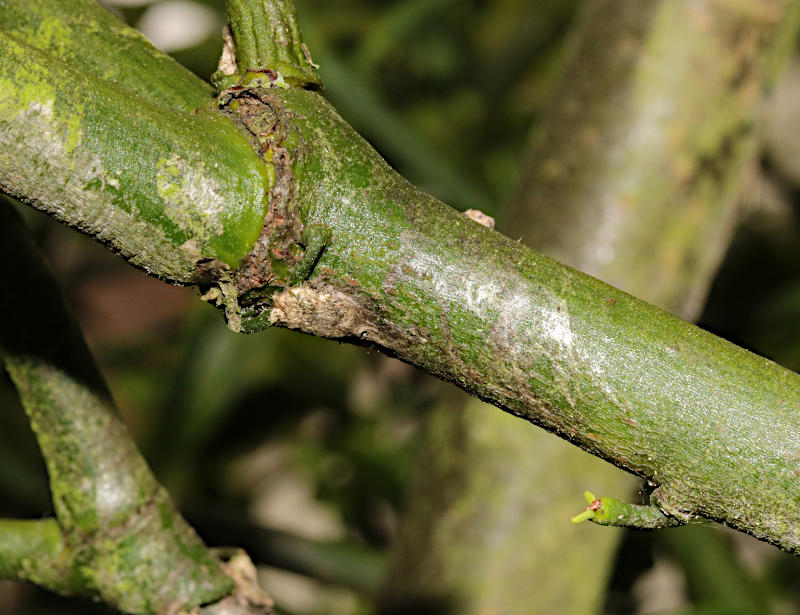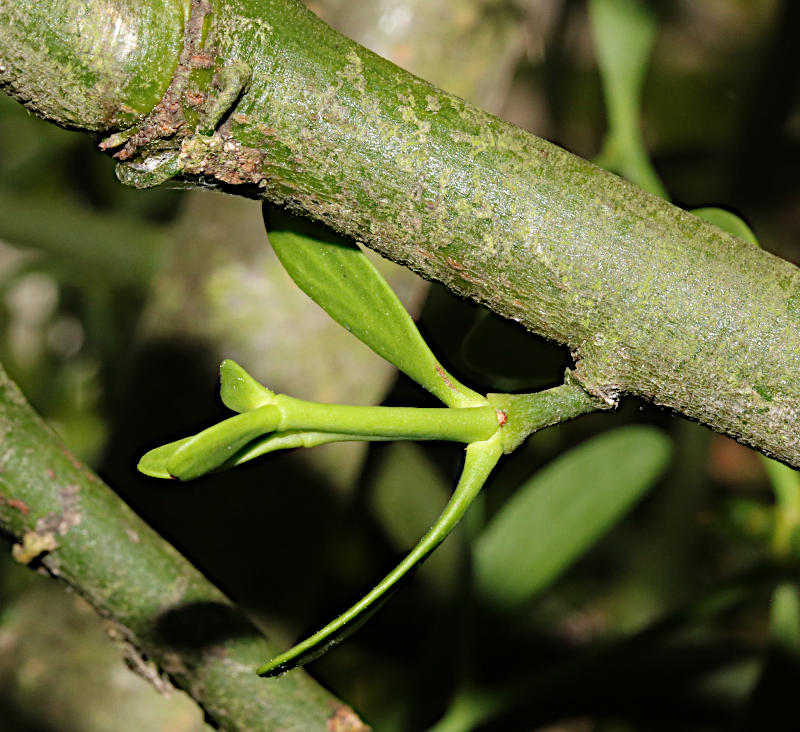This is my own experience of growing mistletoe from seed, with photos of seedlings developing over the years.
There is lots of information on the web, and it seems nothing 'mysterious' about germinating the seed. Unfortunately, lots of the so-called 'information'* on the web (especially those sites which often come up
in searches, but whose content is invariably worthless) is clearly just copied from one site to another with no actual
experience of doing it. I don't often write about stuff I haven't done myself, so here's the actual story, with real pictures, showing
the development of my seedlings on apple, hawthorn, and mountain ash (plus a slightly larger plant I found in the same apple tree).
I'd 'sown' mistletoe berries on garden trees somewhat haphazardly in the past (with no results), but here are some pictures of a
better effort starting in 2012.
On 18th January 2012, I collected some mistletoe berries from plants growing on Hawthorn (Crataegus monogyna),
squeezed out the seeds, and stuck them onto branches of Apple, Hawthorn, and Mountain Ash (or Rowan) in the garden.
The seeds are extremely sticky, so no problem at all attaching them - more problems getting the sticky stuff off my fingers!
I didn't make cuts or anything in the bark - it isn't needed, and after all, birds wiping their beaks wouldn't bother! And
nor did I cover the seeds with anything.
How does the radicle 'know' to grow towards the tree branch? I guess it just grows away from the light.
From what I read (and by now have seen for myself), not much, other than germination, happens for a year or two, during which time the seedling might be eaten by birds or animals. Is it perhaps more a case of waiting for the tree to grow around the 'root', rather than the root 'penetrating' the tree?
I sowed more mistletoe seeds on the apple tree in 2013. With a cold early part of the year, germination only happened in April this time.
* So-called 'information' from the web: Even the Royal Horticultural Society propagates the myth about needing to put seed under
a 'flap' cut in the bark - it isn't needed (indeed some sites say that this would be detrimental, and that the seeds need light).
The RHS follows this 'advice' by saying
that only 1 in 10 seeds germinate - perhaps if they weren't buried under the bark, nearly all would germinate, like mine did.
And a number of sites (no doubt all
copied from one original mistake) say to choose a branch about 20cm (8 inches) in diameter - probably rare for branches to ever reach
this size, and would be old with thick bark - was this a unit conversion error - perhaps should have said 8cm (though even that would
be still rather thick). I think 2cm upwards is plenty - remember that by the time the mistletoe matures, years later, the branch
will have grown.
Mistletoe on apple
Viscum album (European Mistletoe) seeds on apple
Date: 2012 January 18
Mistletoe seeds stuck to a branch of an apple tree. I seem to have stuck them on in rather a regular pattern!
Viscum album (European Mistletoe) seeds germinating on apple
Date: 2012 March 27
Around 10 weeks after 'sowing', the seeds are germinating. I imagine this depends more on the time of year (light and temperature)
than the time from sowing, as the seed stuck to a tree is in a fairly similar situation to when it was still in the berry. I read that
they will germinate anywhere, but obviously only succeed if they happen to be on a host tree.
Although there is usually just one embryo in what appears to be a single 'seed', multiple embryos aren't uncommon. I've read about
sometimes getting two, and in this photo, I've got a 'three' as well.
Viscum album (European Mistletoe) seeds growing on apple
Date: 2012 September 9
Another 6 months or so later, we see the same cluster of 4 seeds. The two at the top still have the same number
of 'shoots' as before. The one at the bottom now only has one remaining out of the two, and it looks like the seed
at the right is going to fail. Unlike in the picture on hawthorn below, there isn't any sign yet of the apple
tissue 'swelling' around the attachment, but then it's a considerably thicker branch (with tougher bark?) than
the hawthorn one.
Viscum album (European Mistletoe) seeds growing on apple
Date: 2013 May 11
Another 8 months later, so 16 months since 'sowing', we see the same seeds. Not much change (well, it's been winter),
and no leaf-growth yet, but the remains of the seeds have further withered away, the 'shoots' have got thicker, and I think
that there is some signs of a bulge developing where they attach (better seen when up the tree taking the photos). One of the
seeds on hawthorn (below) is developing its first leaves.
Viscum album (European Mistletoe) seeds growing on apple
Date: 2013 December 20
Another 7 months later, so 23 months since 'sowing', the growth from the same seeds. The old seed-cases have now
disappeared, and all 5 shoots (including the 3 at the top which originated from the same 'seed') are now free.
Evidently, establishment is a rather slow process - will 2014 (the 3rd year since sowing) bring accelerated
growth? I sowed some more seeds on the same apple tree in early 2013, this time trying thinner branches.
Viscum album (European Mistletoe) seeds growing on apple
Date: 2014 September 27
Another growing season nearly over, and now 32 months since 'sowing', the growth from the same seeds. Still more 'getting
established', rather than lots of leafy growth. Most of the growth is from the base, near the point of attachment, rather
than from the free end of the stem (where the seed originally was). There is another one on this same branch, from seed sown
at the same time, which has more leaves, but it hasn't been in my regular series of photographs. In view of the development
of the larger plant at the bottom of this page, I'd say next year we'll have plenty proper leaves.
Viscum album (European Mistletoe) seeds growing on apple
Date: 2016 February 24
Another growing season over, and now 4 years and 1 month since 'sowing', the growth from the same seeds.
At last, growth is accelerating. No flowers yet, but another one I sowed at the same time (2012) has its first
flowers (the male flowers in the photo further down the page).
Viscum album (European Mistletoe) growing on apple
Date: 2017 December 24
Two growing-seasons since the last photo, and now 5 years and 11 months since 'sowing', the first ripe
berries are visible. As seen in the photos above, this 'clump' consists of several plants, some male and
some female.
To summarise: The mistletoes on apples, sown in January 2012, opened their first male flowers in March 2016 (photo below), and in March 2017 there were female flowers as well, developing into berries by late 2017.
So it was 4 years from sowing to the first male flowers, 5 years for the first female flowers, and nearly 6 years for the
first berries to ripen.
The pattern of male plants flowering at a younger age (4 years from seed) than female plants (5 years from seed) has been
repeated in around 6 which I sowed on apple somewhere else.
Mistletoe seed distribution
Mistletoe seeds sown by a Blackcap (Sylvia atricapilla)
Date: 2018 February 12
With lots of berries early in 2018, no birds touched them until the end of January, when a single female
Blackcap appeared and started to eat them. I saw it several times, over about a week, then it disappeared
with a small proportion of the berries still there. As I had read, Blackcaps separate the seed from the berry,
and wipe their beaks on branches to remove the sticky seed. There are now many seeds stuck to branches on
the apple tree, the hawthorn, and other plants in the garden. I would expect many of these to grow, just
as the ones I sowed myself 6 years ago did, so the apple tree could have a lot of mistletoe in a few
years' time.
The Blackcap appeared again at the beginning of March 2018 during a cold spell with
snow (see photo below), and set about consuming the remaining berries. Interestingly, although Blackcaps
breed in the UK in summer, they used to be rare in winter (the summer birds migrate elsewhere), but since
the 1960s, increasing numbers have been spending winter here after migration from e.g. southern Germany.
Most species of bird don't touch mistletoe berries. The Mistle Thrush (Turdus viscivorus) does, but
I've yet to see any of those in the garden. I once saw a Woodpigeon (Columba palumbus) eating some of
the berries, but although I often see the birds, they don't usually seem to touch the berries.
Whilst Blackcaps wipe the seeds onto nearby branches, birds which eat the seeds whole
and excrete the seeds (as I read Mistle Thrushes do) are likely to transport the seeds
further away.
Female Blackcap (Sylvia atricapilla) with mistletoe berry
Date: 2018 March 4
The birds seem to have quite a struggle to separate the seed from the
outer part which they want to eat.
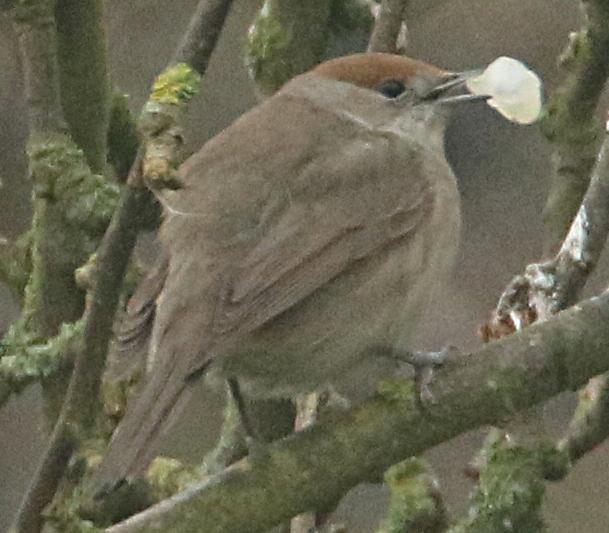
Male Blackcap (Sylvia atricapilla) with mistletoe berry
Date: 2021 February 3
At bottom-centre of this photo, you can see a seed which the bird stuck on earlier.
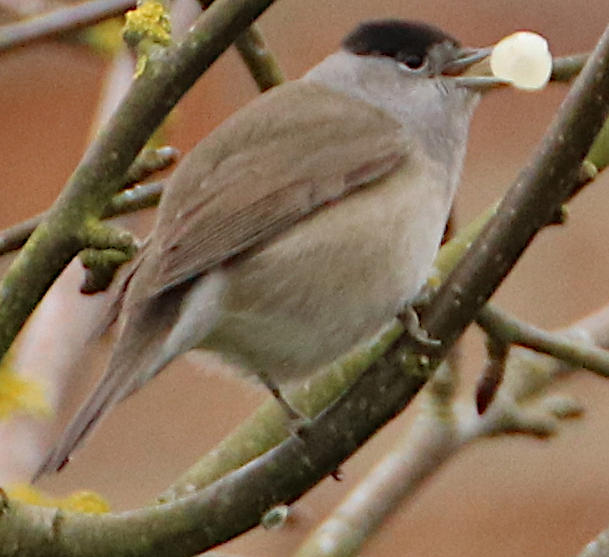
Here are photos of 3 seeds sown by the Blackcap on the apple tree in 2018. This is after the 'sticky-stuff' has
had a week or two to dry. The seeds are on branches around 1cm to 2cm in diameter - the kind of thing that
the bird would perch on.
